Previous Features
Beaver Island State Park Pet Cemetery Remembered
Posted December 22, 2011 at Isledegrande.com
- an Island Dispatch story by Marion E. Klingel
The story has been updated
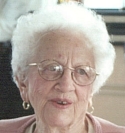
The memory of family pets that roamed the southern part of the Island a century ago was preserved by headstones in a little animal cemetery that remained for years in the undeveloped land that eventually became Beaver Island State Park.
Tucked away in the underbrush at the outskirts of the park was a circlet of eight stones bearing the names Mutz, Carol, Muff, Uncle Mouse, Bruce, Nanette, Tutor and Jack.
Edward J. Zuchowski, Beaver Island State Park superintendent from 1942 through April 1980, made sure the headstones would not be carried away by vandals. He cemented each in place. But time took its toll. A rising river reached the little plot and some of the stones were washed away. Some remain but just where is not known at this writing.
Especially honored way back then was Mutz, whose marker included the inscription: "Loving and Loved in 1918." Mutz is said to have been a mongrel brought to Grand Island from Bermuda by the George E. Matthews family, through the urging of son, Burroughs Matthews, when a small boy. Burroughs later became editor of the Courier-Express.
Jack was a Dalmatian; Nanette a French bulldog of international fame; Muff, a Pomeranian; Uncle Mouse, a former SPCA inmate; and Tutor, a fox terrier.
Bruce and Carol were cats!
First to occupy the land surrounding the cemetery was the once famous Falconwood Club. Later the property became part of the Matthews summer estate and it was the Matthews children who were originators of the pet cemetery. The acreage is said to have been owned by Edwin J. Klopp when it eventually was absorbed by the state for park land in the 1930s. The cemetery's location was in the area of the Ralph Sidway House (current administration building) and the sledding hill.
Islander Recalls World War II Home Front - Nov. 2011
Part III of a three-part seriesWritten in September 1981
By Shirley Kreger Luther
PART III - Oct. 4, 1981 Island Dispatch
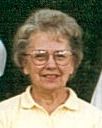
This is the final installment of a speech given by Shirley Luther at the September 1981 meeting of the Grand Island Historical Society: Shirley told of life on Grand Island as she recalled it during World War II (1942-1945) when she edited a hometown newspaper sent to Island servicemen during the conflict.
More comments from the soldiers stationed here:
January 1944 issue - Do all these girls live on Grand Island? All we see are empty houses. The people treat us swell, but how can they live here? I'm going home to California in January to try to thaw out. When we get sent to Grand Island, we consider ourselves in Foreign Service. This is no worse than any other new camp just built, and a lot better than some. We have some of the best cooks in the country here on Grand Island, so why should we kick.
And in reference to the Christmas Party: It was a grand party and a great morale builder. We appreciate what the Island has done for the boys, from Commanding Officer Batt.
Comments from Island servicemen's letters published in the march '44 issue - For close to two years, I have been existing here on Ascension Island - a very barren and desolate place. It amounts to a pile of volcanic ashes and cinders about as big as GI dumped in the middle of the ocean. If you don't feel any sympathy, I'll forgive you, as long as you keep sending the "Islander." PFC Dick McNamee
Although Grand Island means so much to us, it is comparatively small and unheard of in these New England states. Consequently the only news I get of home and of the gang is from the "Islander." Chuck Livingston S 2/c
I am on a South Pacific Island, which I cannot name. We live in tents and the jungle is dense, one can't see 10 ft. ahead. Benj. Running SC 1/c
We are still aboard ship, waiting to go on to our destination. Have been ashore and met some Tonawanda fellows. Also went swimming and ate coconuts. Pvt. Fritz Killian
So far I have made several missions, and know that the rest of the fellows are as anxious to get this thing over and return to Grand Island as I am. T/Sgt. Norm Webb
Several of the boys in my Battery enjoy the paper almost as much as I do, and want to know more about the Island. Sgt. Bill Henry
I have a seven-day furlough coming here in Great Britain soon, and I'm going to try to locate some of the hometown boys. PFC Les Yensan
No matter what the soldiers who were on Grand Island said about it, I think it's a swell place for spooning in the summer. Pvt. Wylie Decker
Seemed good to be able to at least talk to people again. Had to use the sign language where I was, and even that didn't work very good. Here this English money system is the hardest thing to get used to. PFC Charles DeGlopper
Training cruises along the coast made some of the boys seasick, but not an old salt like me, for haven't I lived on the mighty Niagara all these years? Arthur Gehrman A.S.
Am now located at the same camp in Australia much nearer civilization than I was while in New Guinea. John is also over here at a Marine Base on one of the Islands. PFC Cy Kerr
We also saw the Thames River. Its current seems to be as swift as our good old Niagara, and the place I saw it was just as wide. We get a kick out of hearing the English talk. Sgt. Bud Long
If letters suddenly stop coming, you'll know my turn has come to help do a little business over there. Sgt. Dave Stebbin
Any kind of news from the states always makes a fellow feel good so your "Islander" is liked as much by the other fellows as myself. Cpt. Tex Harrison, a pal of Pvt Julius Stenis
The "Islander" has been following me around for some time. I am now in London, a small community of a few million, which is quite different from GI but still appreciate your paper. Cpt. Abram Milner
I had lived on the Island only three months when Uncle Sam snatched me off almost before I had a chance to hang up my hat. But it took less than that to convince me there is no finer spot in which to live. S/Sgt. J. H. Whitmore
The "Islander" eventually came to its journey's end with this message - Well, fellas, here we are at the end of the road. Remember - three years ago, a little paper started traveling to all parts of the world? Its only purpose was to bring a bit of home and news of your buddies to you. With the end of the war, we feel that mission has been accomplished, and the "Islander" has come to the journey's end. With this issue, we are saying finis to a job that had a small beginning but in three years had grown beyond our expectations. Many of you are being discharged now and it is next to impossible to keep our records correct. Some of you may still be away for several months, but we hope it won't be long before you, too, will be home.
We of the staff want to say thanks for your many letters and souvenirs which kept up our morale - And our appreciation goes to all parents and friends, without whose cooperation, the paper could not have existed.
We wish all of you the best of luck as you leave a job that has been well done, and take your place again as civilians. There is a goal still to reach - the attainment of a permanent peace, and we hope for victory in peace as well as in war.
So long G.I.'s
The Editor
Islander Recalls World War II Home Front - November 2011
Part 2 of a three-part seriesWritten in September 1981
By Shirley Kreger Luther
PART II - Sept. 27 1981 Island Dispatch

This is the second installment of the speech made by Shirley Luther at the Sept. 5, 1981 meeting of the Grand Island Historical Society about life on Grand Island during World War II (1942-1945) as she recalled it. Shirley during those years was editor of The Islander, a hometown newspaper sent to Island servicemen during the conflict.
"We published the paper each month and parents, hearing about it, sent us addresses and money. With the February 1943 issue, we added the Catholic Church list, and it truly became an Island-wide servicemen's paper. Letters came back to me from everywhere. The paper was shared with others, and letters came from people we didn't even know. The fellas kept in touch with each other, reading where they were and enjoyed hearing what was going on at home. Some even met overseas and let us know about it. Many of them requested addresses from us so they could write to their friends. At the end, we were mailing over 150 newsletters each month.
Fifty years ago! (now 70 years ago)! It was a time of innocence. How naive we all were. Some of the editorials I wrote seem so simple. It's interesting now to read the gossipy notes of who was moved where, furloughs, transfers, weddings, deaths, births, and comments from the servicemen. (Catherine Killian eventually left and moved to California with husband Harvey Long, and Dorothy Phillips left for Cadet Nursing School, so we ended with a staff of three).
Among the many Islander news items were things I had long forgotten. February 1943 saw rationing books issued at Sidway School with the help of the teachers and other volunteers (I was one of them). Sidway School became the place that the women rolled bandages for the war effort every Friday night. Blood donor days were held at Sidway and each time Grand Island went over the top, having 175 volunteers handled by the Red Cross. Sidway was the focal point of activity and may explain today's effort to keep the school.
Some 400 soldiers, part of an anti-aircraft unit protecting the Niagara Frontier were moved into the Beaver Island Casino. No more swimming.
Our dog "chips" was sent to Nebraska for training for the Dogs for Defense Program. He eventually came home. He was big, but too friendly!
The John Schutt General Store, sight of the Old Bells Store, was sold to Ernie Godfrey.
Memorial Day - 1943 - Several hundred people walked from their respective churches to the Town Hall to dedicate a plaque with 116 names of Isle servicemen. Due to the ban on pleasure driving, the service was to follow the morning church services. Supervisor Reg Long spoke glowingly about our men in service. Unfortunately, the plaque, that stood in the front of the Old Town Hall, was lost in the move to the new Town Hall in the 1960s.
June 1943, the third War Loan Drive went way over the top. Most of us purchased that extra bond. A check was even sent for $400 from overseas to a soldier's parents asking that they buy bonds. The children of Sidway School did their bit by selling $845.75 in bonds and $219.75 in Stamps. Later, in the 4th Loan Drive, Sidway students raised $736 for a yearly total of $3,285.60. Incidentally, the school was filled to capacity, holding classes in the auditorium. We had an enrollment of 250 students.
In August 1943 we were all frightened by the escape of two Nazi Prisoners of War from a Canadian Prison Camp who were believed to have crossed the Niagara River to Grand Island. Everyone was stopped and searched at the two bridges, but they were found in Albany and Canada.
There was also discussion of building a commercial airport here as the Civil Air Authority believed the Buffalo and Niagara Falls Airports would not be adequate after the war.
My brother, Ralph Kreger, returned after 19 months in North Africa with a group of US Technical Representatives of Douglas Aircraft, working with the Army. He then enlisted in the Air Force Cadets.
We were such a rural community at the time. Hundreds of livestock were killed by wild dogs, so NYS put a curfew on dogs - they must be tied sunset to sunrise. We also had a war on rats. The county-wide program paid three cent per rat tail. We even had a wolf hunt, held by the Rod & Gun Club. One wolf was shot on the Grehlinger Farm, now site of the High School. It was later mounded and displayed in the Town Hall.
Christmas arrived and Island organizations sponsored a Christmas Party and dance for the soldiers stationed here. Cookies from the residents, and presents from the Red Cross were provided. Trucks met the girls at the Town Hall and we rode in the trucks to the camps. The newly formed Trinity Service Club attempted to have families take in soldiers for a Christmas dinner.
The end of 1943 - The Islander was a year old and we hoped we would not reach two years old - but we did. By January 1944, we were mailing our newsletter to 140 servicemen - 40 were overseas. The January 1944 issue was also sent to the families. More funds came to us. The Grand Island Transit Company even paid for the paper and mailing of the February issue. Seemed like a lot then, but not now. February 1944 also saw the transfer of the soldiers from Battery C & D - hence no more dances.
Of course, by this time we were receiving letters and comments from our own servicemen as well as those stationed on the Island.
"The Islander may seem unimportant to you at home, but to us it looks like a life raft to a drowning man," wrote bill Rexford
Fellows were amused by comments of soldiers stationed here - This Island is nothing but a spot of desolation. No one can live here - only the wind blows. Nice place - in the summer time, but when do you have summer?
The Trinity Service Club packed 140 boxes and mailed them. In February, Cpl. Joe Killian and Betty Forsythe were married, and Betty eventually went to Texas before Joe went overseas.
In April 1944, the Island Dispatch started publication. Ollie Howard was publisher. Months later The Islander supplied the Dispatch with all the news of our servicemen. The Dispatch later recognized our efforts and awarded our staff the Orchid of the Month award. We received flowers and our picture in the paper. Jack and Bud Senn enlisted in the Marines. Would anyone be left at home?
In May 1944, the Niagara Frontier Planning Assoc. told of the post-war plans to make a thoroughfare from Niagara Falls to Lake Shore across Grand Island and to develop a parkway on our West River. Sidway School was planning to add a second floor. Grand Island property owners asked the State for a yearly bridge pass for Islanders at a cost of $20. It's been an on-going request for 50 years (now 70 years)! Some 182 Rationing Books were stolen from Sidway School. (It was hoped that) Perhaps Miss Connor could tell us more about that.
June 6, 1945 was D-DAY - and everyone prayed the war would soon be over. By August 1944, the barracks around the Island were torn down or sold. Maybe we were no longer worth defending.
To be continued
Islander Recalls World War II Home Front - October 2011
Part 1 of a three-part seriesWritten in September 1981
By Shirley Kreger Luther
PART I - Sept. 13, 1981 Island Dispatch

Life on Grand Island during World War II was delightfully recalled by Shirley Luther at the first fall meeting of the Grand Island Historical Society.
Shirley, editor of the Islander, a newspaper sent to servicemen during the war years, recalled not only events that will go down in town history, but also how Islanders responded during the crisis that began 50 years ago.
The Island Dispatch in this and continuing issues will share with its readers Shirley's account of Life On The Home Front as she saw it in 1941 through 1945.
"Fifty years ago - 1941. According to town census figures, Grand Island had a population of 1,055. My cousin Reg Long was supervisor. We had two bridges - just eight years old, and only the Express Highway or Grand Island Blvd. The Town Board met in the old No. 9 School. It consisted of the Supervisor, two councilmen and two Justices of the Peace. (This was changed in 1972 when we became a first class town). The Grand Island Fire Company was meeting in the original town hall. We had one school - old Sidway, (occupied in 1937, using four classrooms with 100 students). Miss Connor had been with us just five years. After 8th grade everyone was bussed off the island to Tonawanda High School. I remember sitting in Tonawanda High auditorium and all of us crying because war had been declared. Later, I was a member of a canteen group in Tonawanda, formed to have dances for the soldiers and sailors stationed in the area.
"Actually on December 7th, I was with my parents for dinner at the home of Rev. and Mrs. Harvey Schooping in Buffalo. We all crowded around the radio to hear abut Pearl Harbor and the devastation by the Japanese. Somehow, I'm glad no TV was available to show us the horrible details of the sinking of many of our ships.
"The senior class of Tonawanda High School graduation in June 1942 was sad. We'll Meet Again was the class song - we all cried - somehow knowing some of us never would.
"I went to work at Remington Rand in Tonawanda. Gas rationing became a fact of life and carpooling was a must. I was picked up by a friend on his way to work at Curtiss Wright, dropped off at my girlfriend's house, drove her sister's car to Spaulding Fiber in Tonawanda. Her sister worked there.
"My girlfriend and I walked across the railroad tracks to the Remington Rand office to work everyday, and back at night. We did what we had to do. During the years, the work force of the office girls became very close. No men were around to date. We cashed our paychecks each week (mine was $19) hopped on the bus, went to Buffalo, out to eat, shopping and to the show. Not a very exciting life!
"We saw bases established around the Island. East River Road and Ransom, Beaver Island, past the pavilion to the circle area. It was total isolation and as later quoted in the Islander, the soldiers hated it. They had to walk everywhere. I gave many of them rides. Today, we wouldn't dare do that with strangers.
"It was a time before old Trinity Church was moved to its present location. St. Stephen's Church had its barn and our two YF groups mingled and had a good time. Off-Island people couldn't understand how our two groups, Catholic and Protestant, got along so well. City people weren't allowed to intermingle. The Island was really ahead of the times.
"It was a time when nylon stockings were scarce. My brother, home on leave, even stood in line to get a pair for me. "Brotherly love!"
"We had a "Look out tower" at old No. 9 School (now site of the Town Hall). My mother and my aunt were two of the "watchers," looking for enemy planes.
"Islanders collected scrap metal for the war effort. A huge pile of scrap material was accumulated where the fire hall now stands. And Victory gardens were everywhere. A long hard winter delayed our gardens, but we had them. We had to eat.
"It was 4 1/2 years of struggle during the war, sacrifices made by everyone. Men, as well as women, headed for the war plants, building war planes at Curtiss Wright and Bell Aircraft, and our young men left for the war effort.
"By January 1943, there were 70 men in service. The numbers continued to grow. It seemed like a lot to ask from a small town.
"About this time, I was instrumental in starting a newsletter for our servicemen. Calling it The Island, it was published from January 1943 through November 1945. I was the editor. Originally, Mr. Charles Kaegebein from Trinity Church gave me $10 and asked that I write to our boys. Knowing this would be difficult to do on an individual basis, I started the paper. I began with 53 names from Trinity Church. Gradually, the list grew. Edna Schutt Delaney, Dorothy Phillips Mesmer, Gert Cannon Wilson and Catherine Killian Long joined me and became the staff that worked together almost three years at my parents' home. I bought a desk for $5, and had maps of the U.S. and the world on the den walls so we could see where everyone was going. We were even allowed to use the Church mimeograph machine. (Eventually the Town fathers purchased one for us.) Money was really no problem as all the parents donated money. After the final edition in 1945, funds that were left over went to the newly formed Grand Island Memorial Library. A plaque was made for the Island and put on a section of book shelves. I have the plaque. Unfortunately, no date is on it."
To Be Continued
Skate Country Remembered - March 2011
Printed in Island Dispatch, Fri., Feb. 17, 1978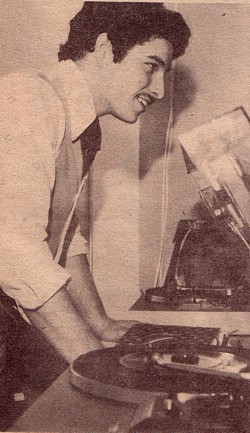
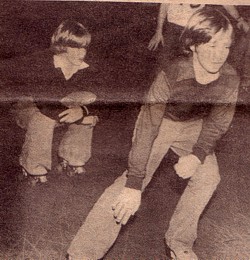
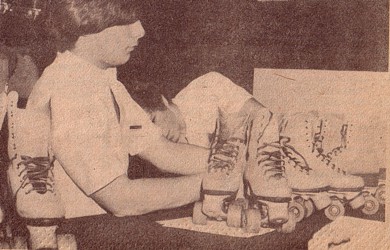
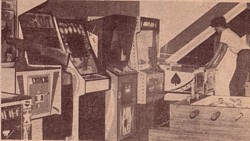
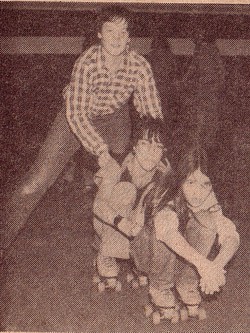
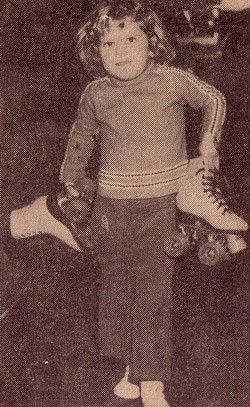
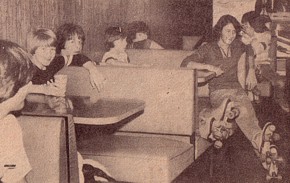
Printed in the Fri., Feb. 17, 1978 Island Dispatch
SKATE COUNTRY OPENS IN ISLAND PLAZA . . .
Skate Country, a rink for roller skating has opened its doors to the youth of Grand Island for a fun time. Monday, Wednesday thru Sunday there is public skating scheduled with a featured family night on Monday 7 p.m. to 9:30 p.m. The admission price is one dollar for a family of four.
Managers Mike Horning and Jeff Mueller have been associated with USA skating but now handle the local facility primarily for Grand Islanders. They have included a snack stand with short order foods, a booth area for eating and a games area to use when the skaters take a break. The staff is drawn 100% from Grand Island High School students and the management is well pleased with their eagerness to do a good job in running the facility or helping to finish up some of the special touches that were not completed before opening.
The search is continuing for a qualified teacher and a pro shop will be added soon. The floor has a wooden base with a urethane finish. We were told that an additional covering will be applied after a short breaking-in time.
Tuesday evenings have been set aside for private parties. The rink can be rented for a nominal charge and the sponsoring group can sell their own tickets to raise funds. The area can easily handle 300 people. Music is provided from a booth with Wayne spinning records and keeping things moving and active. You don't just go and skate, you have a good time. Proper skates are available for renting.
Saturday mornings are reserved for parents and children under 12 and Sunday night is Ladies nite. There is something for everyone!
Island's Original Bridges Are 75 Years Old This Week - July 15, 2010
By Teddy Linenfelser
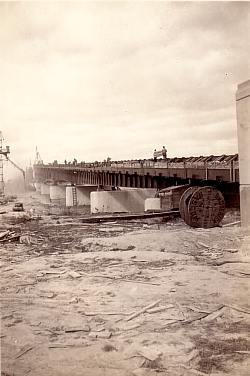
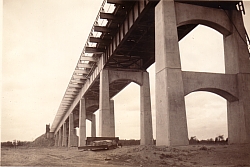
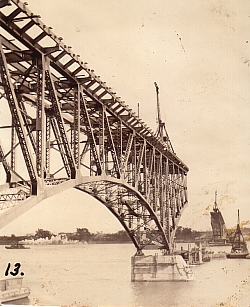
Early series of photos of the south bridge under construction
Click for larger view
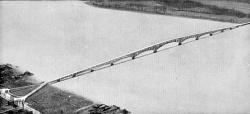

(Left) North Grand Island Bridge with the Niagara Falls terminal on the left. (Right) South Grand Island Bridge connecting to the Island at the lower right of the photo. The photos are part of a 1935 Grand Island bridges brochure of facts including the following: passenger cars 25 cents over two bridges; cost of bridges $3,500,000; length of bridges: north bridge 4000 feet; south bridge: 3400 feet.
Click for larger view
A bridge to Grand Island, New York was first proposed in 1819 and it took “only” 166 years for the north and south Grand Island Bridges to be built and opened to traffic. Proposals for the construction of bridges were also made in 1871 through 1888. Bills were introduced to Congress, meetings were held in Washington, and members of the House Committee on Interstate and Foreign Commerce came to Grand Island to investigate the need for a bridge.
According to the Grand Island Centennial booklet printed in 1952, it was sometime after 1819 that ferry boat service began to operate and serve the people of the Island. The long struggle between then and 1935 when the north and south spans were finally completed, is well documented.
As time went by, it was suggested that the county would build a bridge, or perhaps the state could build a bridge. Then in 1923 the American Niagara Railroad Corporation secured the right from Congress to build bridges across the Niagara from the United States to Canada. Grand Island Supervisor Henry W. Long, and Franklin Sidway and John Schutt, Jr., whom the Town Board sent to Washington on behalf of the bill, returned jubilant over its passage.
The Niagara Frontier Planning Board was created in 1925 by the State Legislature. The Buffalo and Niagara Port Authority in 1928 recommended bridges be built to Grand Island. This was bitterly opposed by the Buffalo Chamber of Commerce. This strong opposition influenced Governor Alfred E. Smith to veto this bill as well as another bill passed by the State Legislature giving a private company the right to build a bridge to Grand Island.
Island officials attended Senate sessions in Albany in 1929 and on March 28 of that year the Schwartz-Frieburg Grand Island Bridge Bill passed with no objection. The creation of the Niagara Frontier Bridge Commission in 1929 was the first tangible progress. It was also in 1929 that the State Legislature appropriated $2,000,000 to be paid in four annual installments of $500,000 to the bridge commission.
The Swartz bill drafted in 1933 by Commissioner Robert Moses, state representative of the Reconstruction Finance Corporation (R. F. C.), passed the Legislature, paving the way for the $2,880,000 loan from the R. F. C.
A February 1, 1933 resolution was passed by the Town Board authorizing the Board to call on Assemblyman Arthur Schwartz and Chairman of the State Council of Parks Robert Moses for the purpose of consulting them in reference to a special legislation pertaining to operation and maintenance of the proposed Grand Island Bridges. In June, a communication was received by the Town Board from the war department regarding a public hearing on the modification of plans heretofore approved for construction of the North Grand Island Bridge and the method of handling traffic on the waterway.
Groundbreaking ceremonies for the bridges in 1933 were made possible by the Act of April 12, 1929 signed by Franklin D. Roosevelt, then governor of New York State.
Excavation for the approach of the South Bridge in the Tonawanda Township began in October 1933. The piers for the first South Bridge extend 72 feet below the river bed.
In December 1934 two workmen were killed by a 100-foot fall into the river; one drowned and the other died on the way to the hospital. As many as 800 men were employed during the construction of the bridges.
While the bridges were under construction in 1934, another great work was going on. The highway from bridge to bridge diagonally across the Island was being built at a cost of $405,144. The town board on September 5, 1935 named it "Grand Island Boulevard."
For several days, cars were crossing the bridges free of charge. On midnight of July 1, 1935 at exactly 12:02 the first toll was rung up, paid by former resident Mr. Herman Alt of Buffalo.
The Tonawanda-Grand Island Ferry at 5:30 in the evening on July 7, 1935 made its last trip carrying a single passenger, Miss Ellen Nice, 80, the daughter of the town's first supervisor, John Nice.
Town folk and their friends assembled on July 13, 1935 at the town hall where a long procession of automobiles formed. The Riverside Community Band, seated on two flat-bed trucks and under the direction of the late Bill Pinkow, led the procession toward the south bridge, and over to the Tonawandas and through Niagara Falls, then back to the Island over the north bridge to Edgewater Park on the east river shore.
Speakers at the park included Town Supervisor John L. Mesmer, Arthur L. Swartz, Charles Freiberg, Reginald F. Long and Franklin St. John Sidway. Sidway paid tribute to William H. Conboy, a former supervisor who was unable to be present, as the man who worked unceasingly for 37 years to secure a bridge.
A buffet supper was served to more than 2,000 people who attended the picnic in Edgewater Park. Pinkow's band played a concert in the afternoon and a dance band from the same group played for dancing in the evening. Mr. Pinkow, who married the former Marion Alt, served many years as a music instructor in Island schools. With the most recent census numbering 626 residents in 1930, the entire Island seemed to come out and take part in this major celebration.
An official dedication by New York State Governor Herbert Lehman took place two days later on July 15, 1935.
The North Grand Island Bridge was awarded the Class A award from the American Institute of Steel Construction for being the most architecturally beautiful bridge of large size in the United States dedicated during 1935.
Evelyn and Carlton Alt, married June 28, 1935, decided to drive across the new south Grand Island Bridge for a visit to a photographer on Niagara Street, Buffalo. Evelyn said it was late in the afternoon and the workmen "moved a lot of equipment to allow us to pass." Elmer Long was best man and Lorna Alt was maid of honor and also took the trip across the unfinished bridge. They returned via the ferry that brought them back to the Bedell House landing.
The following was printed in a Buffalo, NY newspaper in 1935.
”Wednesday at midnight the two bridges connecting Grand Island with Tonawanda and Niagara Falls will be opened for Fourth of July traffic and the dream of making the island a more integral part of the Niagara Frontier will have been realized.”
A second south bridge was completed in October 1962 and the $7.7 million north span opened two years later, 84, feet west of the original north bridge.
Bridge tolls could be the subject of another long story. The campaigns to have them lowered or removed for Island residents has been ongoing right from the opening of the bridges. The toll that started out at 25 cents per car in 1935, was raised periodically. The new and modern EZpass system for paying the tolls was put into use in 1993 and the cost is nine cents per car.
Major Magazine, The Motor Boat, Features Buffalo Launch Club In 1907
Published twice a month - Located at Tenth and Twenty-fifth, 1133 Broadway, New York at 26th Street
Vol. 4 March 10, 1907 No. 5
Posted February 18, 2010 at Isledegrande.com by Teddy Linenfelser
See BLC Clubhouse 1907 Photo
Situated at the junction of Lake Erie and the beautiful Niagara River, Buffalo occupies a geographical position especially adapted to motorboating, and consequently it is little wonder that several hundred motorboat owners are to be found in Buffalo and the immediate vicinity. From the time the lake and river are free from ice in the spring until they are again rendered unnavigable by winter, motorboat enthusiasts dot the water with their pleasure craft, and here, in the Queen City of the Lakes, is the home of the pioneer motorboat club of America. This organization is the Buffalo Launch Club.In the season of 1903 Dr. Albert E. Hubbard, who is now a past commodore and director of the club, had brought to his mind the idea of an organization of motorboat owners who might talk over their experiences and observations, and thus exchange their knowledge. Following out this thought, and in response to an invitation from Dr. Hubbard, a few motorboat owners met at the boathouse of Captain Hager, Squaw Island, Buffalo, on October 9, 1903. After a brief discussion of the mutual benefit which might be derived from such an organization, it was decided to organize the Buffalo Launch Club, and the following officers were elected to direct the club's affairs: Commodore August C. Hager, Vice Commodore Dr. Albert E. Hubbard, Fleet Captain Albert M. Minton, Secretary Irving J. Mills, Treasurer Frank X Argus, Board of Directors Edward Fitzgerald, John P. Mehrhof, Frederick W. Sherman, Ulysses S. Caudell, Warren Kelley. From this unpretentious beginning the Buffalo Launch Club has grown to a large and thriving organization, and has taken a prominent place among the boating clubs, not only of Buffalo, but of the United States.
In the beginning, the club occupied quarters on Squaw Island, and here it rapidly increased its membership, and established a firm foundation for greater things to come in its more advanced stage of development. Many good races were held, some enjoyable cruises were taken, and much scientific knowledge acquired by the members from the constant interchange of ideas on gasoline motors, boats and similar topics. Dr.Hubbard read before the club a series of lectures on electricity as applied to gas engines. These talks were very helpful to the members.
For more than two years the clubhouse on Squaw Island was the scene of many pleasant gatherings and enjoyable holidays. However, it gradually became apparent to the club that an out-of-the-city clubhouse was needed. So, at an informal meeting, held February 5th, 1906, Commodore Hubbard announced that he had received an offer from the Bedell Estate to sell the club a portion of their property on Grand Island. With but eighteen members present at this meeting, before its adjournment there had been $750 given and $3,000 of bonds subscribed for to buy the new site and erect a clubhouse. The offer was forthwith accepted, and it was not many months before Grand Island was the location of one of the finest clubhouses of its kind in existence.
The building is located on the east bank of Grand Island, facing the east branch of the Niagara River, and within three minutes' walk north of the landings of the Bedell House and the Grand Island ferry boats, making it the most accessible spot near Buffalo for such a station. There is hourly ferry service during the whole year between the clubhouse and Buffalo. The house is a frame structure of Colonial design, three stories high, the length, including verandas, being 106 feet, with a depth of 42 feet. Spacious grounds surround the house and are made beautiful by terraces, shrubbery, flowerbeds, tennis courts and an attractive lawn. In front of the clubhouse, an L-shaped pier, extending 150 feet into the river and thence 150 feet down stream, forms a harbor for the launches of the members. On three sides of the building are wide verandas, which command a picturesque view of the Niagara River, with Buffalo in the distance.
The interior of the house is even more attractive than the exterior. From the lower veranda, wide doors lead into the reception hall, which is 18x30 feet, with a massive Colonial fireplace and winding staircase. To the north side of the hall is a spacious dining room, 30x35 feet, furnished with beautiful Mission furniture. On the south side is a parlor, 12 x 18 feet, and also a ladies' parlor and retiring room of the same size. Extending between these is a hallway leading to a well equipped pool and billiard room, 20 x 30 feet. The hall and dining room are so arranged that they can be opened to form one large room, when desired, for dancing or large receptions. On the second floor, besides the board of directors' room, there are thirteen comfortable sleeping apartments, one hundred convenient lockers, a linen room, and a bathroom equipped with a large shower and other convenience. The third floor, or what is known by the club as "Dream Hall," is a large airy room with picturesque views from all of its four sides. Here are sleeping accommodations for at least one hundred persons, and it is a favorite rendezvous for the tired yachtsmen on sultry summer days. The cost of the land and buildings was $15,000.
The Buffalo Launch Club has a constitution and bylaws which have worked out very successfully in the management of this association, and they have been used as a model by many similar organizations throughout the United States. The club was incorporated December 31, 1903, and since its incorporation it has been run on a sound financial and businesslike basis. The officers of the club for the current year are Commodore Louis A. Fischer, Vice Commodore Frederick Fenster, Secretary Harry H. Simpson, Treasurer Frank X. Argus, Fleet Captain G. B. Eggert, and Fleet Surgeon Dr. E. H. Tweedy. The board of directors is composed of Dr. A. E. Hubbard, J. W. Ashley, Albert Dohn and F. R. Metcalf.
The membership of the club long ago passed the original limit, and now there are two hundred and sixty members. A large portion of the members are owners of motorboats, and an important regulation of the club is that only motorboats can fly the club colors. Among the non-resident members who fly the Buffalo Launch Club colors are C. L. Newman and H.W. Dunn, Halifax, N. S., and W. A. Cloud, London, England.
Each year there are many lively races held under the auspices of the club and these are always largely attended. One feature to which the large attendance and general enthusiasm is attributable is the fact that when races are scheduled by the club, they are held at the time and place appointed, without regard to unfavorable weather conditions or similar objections. When a race is advertised, it is held, and there are no delays or disappointment. In the race for the Letchworth trophy last year, between the Buffalo Motor Boat Club and the Launch Club, the latter succeeded in carrying away the laurels. One of the fixed events of the season to which the club looks forward with great pleasure is the yearly race from Port Maitland, Ontario to Buffalo. This event is especially for cruising launches and is invariably held on Labor Day. Some of the fast boats owned by members of the club are the Niagara, which has done better than 25 miles an hours; Arab, 23 miles; Dolphin, 21 miles, King Bee, 21 miles, Wizard II, 20 miles, Whiz, 18 miles. Already two members of the club have signified their intention of having boats built which will make better than 28 and perhaps 30 miles an hour, and the outlook for the coming season is very promising. It is safe to predict that there will be not only some famous racing events, which will eclipse all former club meets, but also more good fellowship and general entertainment than ever before in the history of the club.
Joseph A. McGuire
Angelo LaDuca Featured In Art Show
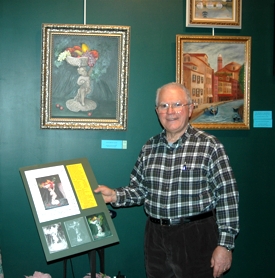
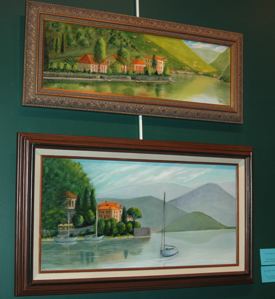
Left: Angelo LaDuca displays the steps in creating his art, right: Lake Como paintings.
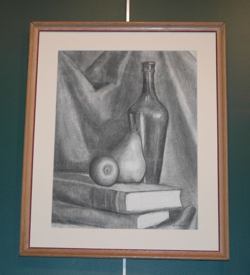


From left: first drawing, first pastel and first oil painting. Click photo for larger view
Island resident Angelo F. LaDuca was recently the featured artist in a one-man show at the Partners In Art Gallery located in downtown North Tonawanda. What makes that so interesting is that he is fairly new to the art scene, having started just six short years ago and that this was his second major show in the past year. Angelo was one of four alumni artist invited to take part in a Colgate University Class of 1959 50th Reunion, a month long exhibit in May of 2009. He was interested in art in his youth, but without any encouragement from a college art professor, went on to become a lawyer and real estate appraiser/realtor for over 40 years. At Angelo's retirement four years ago, and with encouragement from his wife Barbara he began taking weekly classes, many in the Partners In Art Complex located on Webster Street. Partners in Art was founded in 1995 by artists Joan Horn and Glenna Sternin to benefit the artists and art communities of Western New York.
Angelo has stated that anyone can do as well or even better than he as an artist, if that person applies himself. He is the consummate student of art, with a large reference library and many hours spent taking classes in drawing, color, perspective, composition and painting technique. His recent show featured 76 drawings, pastels and oil paintings. He has traveled the world and painted landscapes from photos of his travels. Featured in the recent art show were wonderful paintings from Lake Como - Italy, Japan and China, and the northwest United States and Canada. To become an artist, Angelo believes: 1. drawing skills are foundation, 2. principles are the structure and 3. attitude makes it happen. Check out a list of principles of art checklist that he has compiled. Angelo will again be featured at the Partners In Art Gallery this month. The public is welcome to attend the 13th annual student show that will run from February 6th through February 26th, Tuesday - Saturday from 10:00 a.m. to 5:00 p.m., 74 Webster Street, North Tonawanda.




